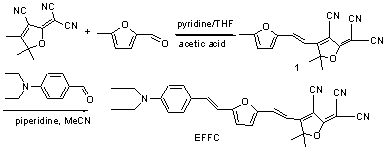[1] Zhang, X.-L.; Li, M.; Shi, Z.-S. Dyes Pigm. 2012, 92, 982.
[2] Jang, S.-H.; Luo, J.-D.; Neil, M. T. Chem. Mater. 2006, 18, 2982.
[3] Xiao, L.-F.; Chen, C.; Wu, J.-Y.; Tian, Y.-P.; Jin, B.-K. Acta Chim. Sinica 2011, 69, 2543. (肖陆飞, 陈晨, 吴杰颖, 田玉鹏, 金葆康, 化学学报, 2010, 69, 2543.)
[4] Ji, Y.; Qian, Y.; Zhou, Z.-Q.; Cui, Y.-P. Acta Chim. Sinica 2011, 69, 2499. (吉彦, 钱鹰, 周志强, 崔一平, 化学学报, 2011, 69, 2499.)
[5] Piao, X.-Q.; Zhang, X.-M.; Shinichiro, I. Org. Electron. 2011, 12, 1093.
[6] Rao, V. P.; Wong, K. Y.; Jen, A. K.-Y. Chem. Mater. 1994, 6, 2210.
[7] Zhang, C.; Dalton, L. R.; Oh, M.-C.; Zhang, H.; Steier, W. H. Chem. Mater. 2001, 13, 3043.
[8] Cheolsoo, J.; Mitsutoshi, J.; Masa-aki, K. Opt. Soc. Am. B 1998, 15, 471.
[9] Dalton, L. R.; Robinsona, B. H. Proceedings of SPIE 2000, 4114, 67.
[10] Robinson, B. H.; Dalton, L. R.; Harper, A. W. Chem. Phys. 1999, 245, 35.
[11] Guo, K.-P.; Hao, J.-M.; Zhang, T. Dyes Pigm. 2008, 77, 657.
[12] Myung, H. K.; Mai, H. H.; Dong, H. C.; Min, J. C. Macromol. Res. 2011, 19, 403.
[13] Liu, J.-L.; Hou, W.-J.; Feng, S.-W. J. Phys. Org. Chem. 2011, 24, 439.
[14] Bong, R. C.; Ki, N. S.; Seung J. L. Tetrahedron Lett. 1998, 39, 3167.
[15] Gong, W.; Li, Q.-Q.; Li, S.-Y. Mater. Lett. 2007, 61, 1151.
[16] Liu, H.-B.; Qiu, Y.-Q.; Sun, S.-L.; Liu, C.-G.; Sun, X.-N. Acta Chim. Sinica 2010, 68, 2509. (刘海波, 仇永清, 孙世玲, 刘春光, 孙晓娜, 化学学报, 2010, 68, 2509.)
[17] He, M.-Q.; Thomas, M. L.; John, A. S. S Chem. Mater. 2002, 14, 4669.
[18] Han, L.-K.; Jiang, Y.-D.; Li, W. Mater. Lett. 2008, 62, 1495.
[19] Tang, X.; Tang, X.-Z.; Zhao, B.; Wang, Y. J. Funct. Mater. 2010, 41, 1340. (唐翔, 唐先忠, 赵波, 王洋, 功能材料, 2010, 41, 1340.)
[20] Tang, X.; Tang, X.-Z.; Wang, Y. J. Optoelectronics Laser 2010, 21, 1196. (唐翔, 唐先忠, 王洋, 光电子·激光, 2010, 21, 1196.)
[21] Li, M.; Zhang, X.-L.; Shi, Z. S.; Wan, Y.; Zhao, L. S.; Jin, R. L.; Yu, Y. H.; Yi, M. B.; Cui, Z. C. Opt. Mater. 2012, 34, 705. |
